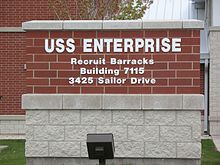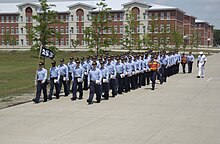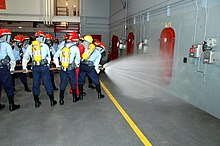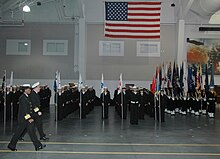| Revision as of 10:45, 24 July 2008 editRossusna02 (talk | contribs)119 editsm →External links← Previous edit | Revision as of 16:28, 24 July 2008 edit undoXymmax (talk | contribs)Administrators12,138 edits copy editingNext edit → | ||
| (One intermediate revision by the same user not shown) | |||
| Line 1: | Line 1: | ||
| ] | ] | ||
| ''' |
The '''Recruit Training Command''' is the organization within the ] responsible for conducting the initial orientation and training of newly ] recruits. It commonly is referred to as "boot camp" or ], and is approximately eight weeks long. Upon successful completion of basic training, qualifying sailors (graduates) are sent to one of various technical training programs, known as "A Schools", where they begin training to qualify for a particular job, or ] Sailors who do not enter A School attend general apprenticeship training, and begin their careers with a general designation of Airman, Fireman, or Seaman. The Recruit Training Command is located at ], near ]. | ||
| ==History== | ==History== | ||
Revision as of 16:28, 24 July 2008
The Recruit Training Command is the organization within the United States Navy responsible for conducting the initial orientation and training of newly enlisted recruits. It commonly is referred to as "boot camp" or Recruit Training, and is approximately eight weeks long. Upon successful completion of basic training, qualifying sailors (graduates) are sent to one of various technical training programs, known as "A Schools", where they begin training to qualify for a particular job, or rating. Sailors who do not enter A School attend general apprenticeship training, and begin their careers with a general designation of Airman, Fireman, or Seaman. The Recruit Training Command is located at Naval Station Great Lakes, near Chicago, Illinois.
History

After the Spanish-American War, planners in Washington decided to locate a training center in the middle of the geographic area that contributed 43 percent of the Navy’s recruits--the Midwest.
Navy boards investigated 37 sites around Lake Michigan. Congressman George Edmond Foss, representative from Illinois and chairman of the Committee on Naval Affairs from 1900 to 1911, pressed for the decision to locate the center at its present location. Called “The Father of Great Lakes” for his efforts, today North Chicago’s Foss Park--which is immediately north of the base--bears his name.
Rear Admiral Albert A. Ross was the station’s first commander. Ross Field and Ross Auditorium on are named in his honor. The first flag was planted on site on July 1, 1905. President William H. Taft dedicated the station six years later on October 28, 1911. In that same year the station received its first trainee, Seaman Recruit Joseph W. Gregg.

Great Lakes was a pioneer in racial integration of the Navy. In mid-1942, the Navy began accepting African-American enlistments for general service. In February 1944, the Navy commissioned its first African-American officers. The twelve commissioned officers, and a warrant officer who received his rank at the same time, came to be known as the “Golden Thirteen.” During the summer of 1987, the present Recruit In-Processing Center was dedicated in their honor with the eight surviving members of the “Golden Thirteen” in attendance.

Navy recruit training is now exclusively conducted at Naval Station Great Lakes' Recruit Training Command. Prior to the mid-1990s recruit training facilities included Naval Training Center Orlando and Naval Training Center San Diego. Female recruit training was previously limited to the Orlando facility. The Base Realignment and Closure Commission of 1993 resulted in the consolidation of recruit training to Great Lakes. Following the consolidation, the Navy undertook a massive recapitalization (recap) program to upgrade the Great Lakes Recruit Training facility. The recap included the construction of Camp John Paul Jones, a 48 acre site on land formerly owned by the VA Hospital adjacent to Camp Porter. New barracks were also constructed, they are referred to as "ships" by the recruits. The ships were also given names to honor an important ship in naval history, such as USS John F. Kennedy and USS Enterprise. Each "ship" can house up to 1300 recruits during training. A 210-foot Arleigh Burke class destroyer simulator called USS Trayer (BST 21) was also constructed as part of the recap program also known as Battle Stations 21 (BST 21).
Facilities


USS Enterprise (BLDG 7115)
USS Enterprise (BLDG 7115) is a commissioned building located at Recruit Training Command on Naval Station Great Lakes in Great Lakes, Illinois.
The USS Enterprise Recruit Barracks Building was built as part of a $763 million recapitalization program. This USS Enterprise is particularly notable since even though it is a building it has been commissioned U.S.S. and it was commissioned while another USS Enterprise (CVN-65) was still in service. Currently this is the only building in the history of the United States to be commissioned USS Enterprise. Approximately 4,775 civilians are transformed into smartly disciplined, physically fit, basically trained sailors aboard this ship each year. The building has a Ship's Officer, who fills the role of Commanding Officer, a Ship's Leading Chief Petty Officer, who fills the role of Command Senior Chief, and a Chaplain.

The building is named after the eight United States ships that have borne the name, including the two famous aircraft carriers pictured around the building's "quarterdeck". The first is CV-6, which was a ship of the Yorktown class launched in 1936, and one of only three American carriers commissioned prior to World War II to survive the war. The nautical flags hanging on the quarterdeck of BLDG 7115 are from CV-6. The second is CVN-65, the world's first nuclear-powered aircraft carrier. Many of the displays on the quarterdeck of USS Enterprise (BLDG 7115) were donated by the CVN-65 Enterprise.
USS Enterprise (BLDG 7115) has 120,000 square feet (11,000 m) of space, enough to accommodate 16 recruit divisions of up to 88 recruits each. This facility integrates berthing, classrooms, learning resource centers, a galley, and quarterdeck, all under one roof.
USS Enterprise and the other new barracks are located in a section of Recruit Training Command called Camp John Paul Jones, a 48 acres (0.19 km) parcel of land that was acquired from the United States Veterans Administration.
Recruit Training Command’s recapitalization project includes the construction of Battle Stations 21, a full-size ship simulator with state-of-the-art special effects designed by the entertainment and theme park industries.
Training Timeline
Processing Week




Navy Recruits begin their journey at Building 1405, Golden Thirteen, the Recruit In-processing Center in Camp Moffett. Recruits arrive at all hours, but mostly during the night. Before formal training can begin at Recruit Training Command, Recruits are screened medically, dentally, and administratively. They receive a thorough round of inoculations, an initial issue of uniforms, and their first military haircut. They are taught basic grooming standards, the Uniform Code of Military Justice (UCMJ), standards of conduct, and are introduced to their Recruit Division Commander (drill instructor).
This first week of training called P-Days (processing days) lasts for approximately five days, but can run a little longer depending on weekends, holidays, and the schedule of arriving Recruits. During P-days, Recruits will be taught the basics of watch standing, they will be given information to memorize, and they will begin learning to organize their gear. P-Days conclude with a commissioning ceremony, led by the Recruit's Group Commander (Ship's Officer) in which their division receives its guidon (divisional flag displaying division number). This ceremony marks the official start of their training.
Week One
This week is considered the most intense week of physical conditioning. Recruits take their initial swim qualification test, learn military drill, the details of rank and rating, and the Navy core values.
Week Two
During Week Two, recruits learn the Navy chain of command, custom and courtesies, and basic watchstanding. Recruits will also run the Navy Confidence Course.
Week Three
Week Three consists of hands on training. Recruits will learn laws of armed conflict, money management, basic seamanship, shipboard communication, and Navy ship and aircraft identification. Recruits also take their first physical training test, consisting of curl ups, sit-reaches, push ups, and a 1.5 mile run.
Week Four
Week Four mostly consists of weapons training. Recruits are familiarized with the M9 and the Mossberg 500 or Remington 870. (the Navy no longer gives weapons training on the M-16).
Week Five
Week Five consists of more Navy classroom time.
Week Six
During Week Six, recruits learn shipboard damage and firefighting skills. Recruits will learn to escape smoke-filled compartments, open and close watertight doors, use self-contained breathing apparatus, carry fire hoses and learn to extinguish fires. Week Six also consists of the Confidence Chamber (tear gas chamber).
Week Seven
Week Seven is the last week of Navy Basic Training. These seven weeks, combined with Processing Week, makeup the approximate eight week training cycle that each Recruit must complete before graduating. Week seven consists of the accumulation of Navy Basic Training in a gruelling 12 hour exercise called "Battle Stations". This reinforces much of the instruction learned during Basic Training. Recruits have to pass all the requirements of Basic Training in order to participate in "Battle Stations". Once Recruits have successfully completed "Battle Stations" they become Sailors, don their Navy Ball Cap and are permitted to Pass In Review (PIR) at the USS Midway, Ceremonial Drill Hall, officially marking their graduation and entrance into the fleet of the United States Navy.
References
- Naval Station Great Lakes Base Guide & Telephone Directory, Page 46
- Naval Station Great Lakes Base Guide & Telephone Directory, Page 46
- Naval Station Great Lakes Base Guide & Telephone Directory, Page 47
- Naval Station Great Lakes Base Guide & Telephone Directory, Page 47
- SECNAV Visits Naval Station Great Lakes. Friday, October 13, 2006.
- RTC Ground-Breaking Ceremony Paves Way for Camp John Paul Jones. 10/2/2002 11:51:00 PM.
- Where do I sleep?.
- Trayer Commissioned at RTC. 6/20/2007 4:25:00 PM.
- "USS Enterprise Commissioned at RTC". Naval Media Center, Daily News Update. 2005-06-20.
{{cite web}}: Check date values in:|date=(help) - Strickland, Aaron (2007-09-08). "PCU George H.W. Bush Training Division Commissioned at RTC". Navy NewsStand.
{{cite web}}: Check date values in:|date=(help) - RTC's Official P-Day Description
- RTC's Official P-Day Description
External links
- Official Website
- Navy.com Overview
- About.com
- Camp Moffett - Design Immerses Recruits In Patriotism, Navy Story
- Official USS Enterprise (BLDG 7115) Navy Video
This United States Navy article is a stub. You can help Misplaced Pages by expanding it. |
This Illinois-related article is a stub. You can help Misplaced Pages by expanding it. |